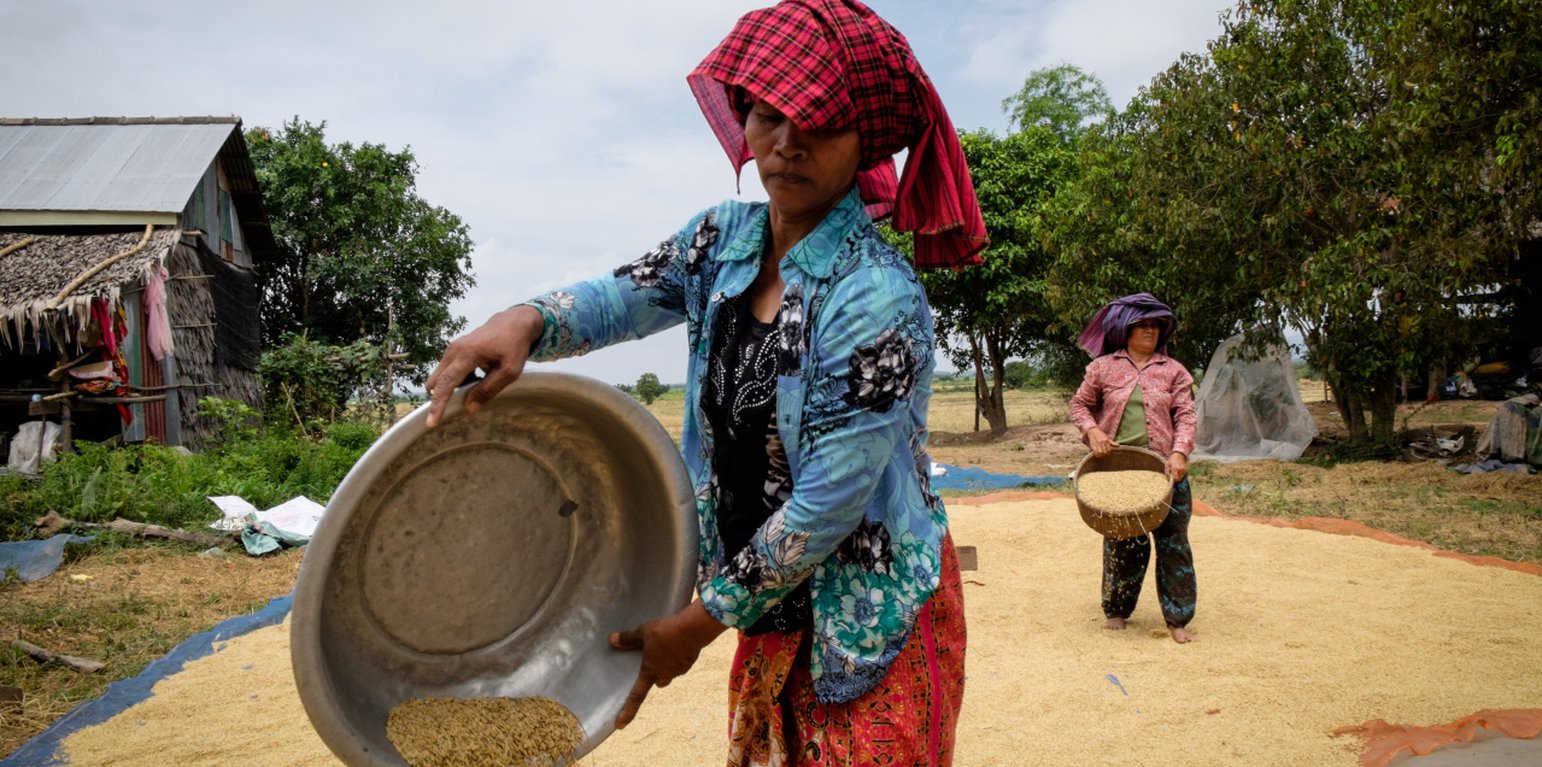Community Safety Nets - Establishment of rice seed banks at village level
(ກໍາປູເຈຍ)
ຄຳອະທິບາຍ
A rice (seed) bank is a community safety net system where farmers can get both rice seeds for cultivation and rice for consumption from a communal storage house in order to increase their food security by guaranteeing: (1) year-round access to high quality seeds and rice for consumption, (2) access to seed and rice for consumption after an extreme weather event (drought, flood) and (3) improved quality of the planted seeds through the provision of new varieties better adapted to local conditions (e.g. fast maturing, floating rice)
A rice (seed) bank is a system where farmers can get both high quality rice seeds for planting and rice for consumption from a communal storage house. Requirement for the use of the rice (seed) bank is that farmers pay back the purchased rice seeds or rice for food with a 20% interest rate after their next harvest. The bank is managed by a community council consisting of members of the village in collaboration with the local NGO Society for Community Development in Cambodia - SOFDEC.
The rice (seed) banks act as a community safety net in the villages to guarantee food security despite the threat of extreme weather events such as drought or flood. Because of the constant access to high quality seeds, farmers can sow a second time in case the first sowing was lost due to a drought or flood. Also, the communal storage of rice for consumption helps particularly poor farmer families with small plots in case they do not get enough yield on their field to feed the household.
Moreover, new rice varieties, which are better adapted to local conditions and which also perform in the case of extreme weather (fast maturing, floating rice) are introduced through the rice (seed) bank. Besides these new varieties (the result of research carried out by the Local Agricultural Research and Extension Center LAREC in collaboration with other research institutes) have higher yields and can also be sold at a better price on the market.
The need for a rice (seed) bank is decided in participatory manner by the village community. In case a bank is established it is managed by a community council of elected community members. The council is responsible for the storage, the distribution and supervises the back payment of the rice (seed). Through the collaboration between the Community Council and SOFDEC, new SLM Technologies such as the System of Rice Intensification can be promoted in the target villages.
The stages of implementation are as follows:
1. SOFDEC consults with the villagers about the aim and the need for a rice (seed) bank. Generally, rice banks are established if farmers express that there is a high exposure to extreme weather event, low food security and/or rice seeds are of bad quality (bad germination, low yields).
2. The decision about the establishment and implementation of a rice (seed) bank is made by the village community.
3. A Community Council is elected by the villagers and trained on their role and functioning of the rice (seed) bank by SOFDEC staff.
4. The communal storage is built. Building materials are provided by SOFDEC, the community contributes with labor.
5. SOFDEC provides a first stock of high quality rice seeds from LAREC and rice for consumption.
6. After the first harvest, the farmers pay back the seeds and rice consumed with a 20% interest rate.
7. SOFDEC monitors the functioning of the rice seed banks and takes a mediating role in case that problems between the community council and the village community arises.
ສະຖານທີ່
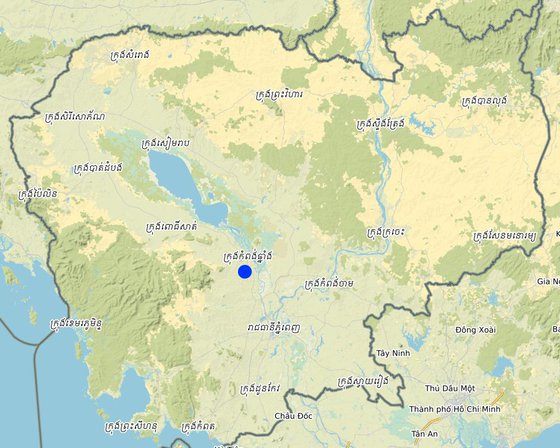
ສະຖານທີ່: Different districts, Kampong Chhnang, ກໍາປູເຈຍ
ການຄັດເລືອກພື້ນທີ່ ທີ່ອີງໃສ່ຂໍ້ມູນທາງພູມີສາດ
ວັນທີເລີ່ມຕົ້ນ: 2000
ປີຂອງການສິ້ນສຸດ: n.a.
ປະເພດຂອງແນວທາງ
-
ພື້ນເມືອງ / ທ້ອງຖີ່ນ
-
ການລິເລີ່ມ ພາຍໃນປະເທດ ທີ່ຜ່ານມາ / ນະວັດຕະກໍາ
-
ພາຍໃຕ້ໂຄງການ / ແຜນງານ
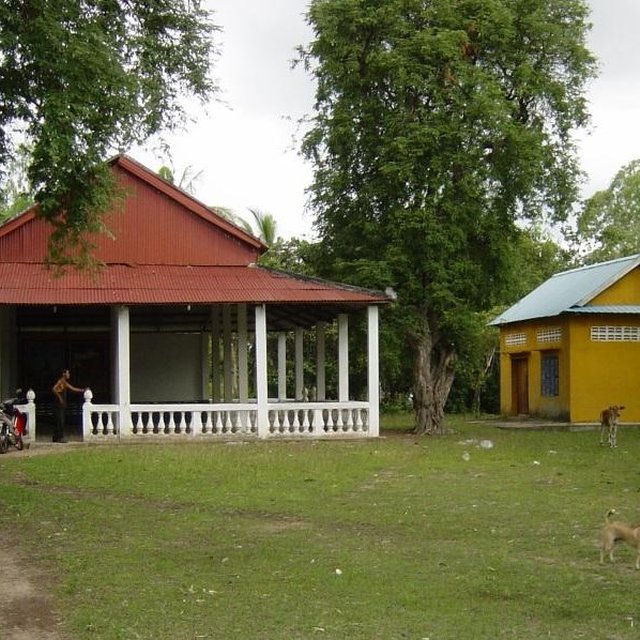
Rice bank to the right side of the village meeting hall (Stefan Graf)
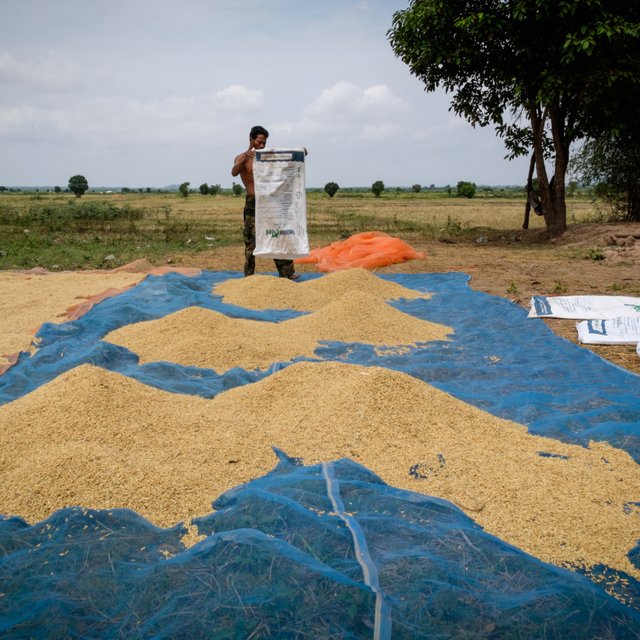
Rice harvest (Christian Bobst)
ເປົ້າໝາຍຂອງແນວທາງ ແລະ ການປົກປັກຮັກສາສິ່ງແວດລ້ອມ
ເປົ້າໝາຍ / ຈຸດປະສົງຫຼັກໃນການຈັດຕັ້ງປະຕິບັດແນວທາງ
The main aim of the approach is to increase the resilience of farmer families by improving their food security (rice seeds and rice for food are now available the whole year round, mutual support after droughts or floods possible), increasing their income (rice varieties higher yielding) as well as strengthening local institutions (community committees manage the rice banks, and participate in decision making on a local level).
ເງື່ອນໄຂທີ່ສະໜັບສະໜູນໃຫ້ການຈັດຕັ້ງປະຕິບັດເຕັກໂນໂລຢີ ບົນພື້ນຖານແນວທາງ
-
ສັງຄົມ / ວັດທະນະທໍາ / ມາດຕະຖານ ແລະ ຄຸນຄ່າທາງສາສະໜາ: Willingness of the community to support each other through a safety-net system
-
ມີຄວາມສາມາດ / ເຂັ້າເຖິງຊັບພະຍາກອນດ້ານການເງິນ ແລະ ການບໍລິການ: First inputs for the establishment of the rice (seed) banks are provided by the project (materials for the building of the bank, improved and locally adapted rice seed from LAREC)
-
ການຮ່ວມມື / ການປະສານງານຂອງຜູ້ກ່ຽວຂ້ອງ: Rice (seed) banks are decided upon and managed by the community itself through an elected community council
-
ຄວາມຮູ້ກ່ຽວກັບການຄຸ້ມຄອງ ທີ່ດິນແບບຍືນຍົງ, ການເຂົ້າເຖິງການສະໜັບສະໜູນ ທາງດ້ານວິຊາການ: Through research done by the Local Agricultural Research and Extension Center LAREC, the rice varieties in the rice banks are adapted to the needs of the farmers (e.g. higher yielding, short breeding, drought resistant). Through the SOFDEC programme farmers are furthermore capacitated in new cultivation techniques (such as System of Rice Intensification - SRI).
ເງື່ອນໄຂທີ່ເຊື່ອງຊ້ອນໃຫ້ການຈັດຕັ້ງປະຕິບັດເຕັກໂນໂລຢີ ບົນພື້ນຖານແນວທາງ
-
ສັງຄົມ / ວັດທະນະທໍາ / ມາດຕະຖານ ແລະ ຄຸນຄ່າທາງສາສະໜາ: Some farmers are reluctant to be part of the rice (seed) bank, as they do not want to use/consume someone else's rice, which might be of different quality than his/her own
-
ມີຄວາມສາມາດ / ເຂັ້າເຖິງຊັບພະຍາກອນດ້ານການເງິນ ແລະ ການບໍລິການ: Some farmers struggle to repay the amount of rice borrowed including the requested interest rate of 20%, particularly after an extreme weather event (drought, flood)
-
ຄວາມຮູ້ກ່ຽວກັບການຄຸ້ມຄອງ ທີ່ດິນແບບຍືນຍົງ, ການເຂົ້າເຖິງການສະໜັບສະໜູນ ທາງດ້ານວິຊາການ: Lack of technical knowlegde on high quality seed multiplication leads to rice seed supply of bad quality in the rice bank.
ການມີສ່ວນຮ່ວມ ແລະ ບົດບາດຂອງພາກສ່ວນທີ່ກ່ຽວຂ້ອງທີ່ມີສ່ວນຮ່ວມ
ພາລະບົດບາດຂອງພາກສ່ວນທີ່ກ່ຽວຂ້ອງ ທີ່ມີສ່ວນຮ່ວມໃນການຈັດຕັ້ງປະຕິບັດແນວທາງ
| ແມ່ນໃຜ / ພາກສ່ວນໃດ ທີ່ເປັນເຈົ້າການ ໃນການຈັດຕັ້ງປະຕິບັດ ວິທີການ? |
ລະບຸ ພາກສ່ວນທີ່ກ່ຽວຂ້ອງ |
ພັນລະນາ ບົດບາດ ໜ້າທີ່ ຂອງພາກສ່ວນທີ່ກ່ຽວຂ້ອງ |
| ຜູ້ນໍາໃຊ້ດິນໃນທ້ອງຖິ່ນ / ຊຸມຊົນທ້ອງຖິ່ນ |
Farmers |
Farmers can borrow rice seed and in case of a disaster also rice for consumption from the rice bank. After their next harvest the farmers have to pay back the rice (seed) borrowed with a 20% interest |
| ອົງການຈັດຕັ້ງ ພາຍໃນຊຸມຊົນ |
Community council |
Community Councils are elected by the community and are managing the rice banks and make sure that the regulation are met by the farmers participating in the rice banks |
| ອົງການຈັດຕັ້ງ ທີ່ບໍ່ຂື້ນກັບລັດຖະບານ |
Society for Community Development in Cambodia - SOFDEC |
SOFDEC is responsible for the planning and design of the approach, implementation of rice banks as well as for the financing of the initial establishment of the rice banks. |
| ອໍານາດ ການປົກຄອງທ້ອງຖິ່ນ |
village chief |
The village chief facilitates the introduction of the rice seed bank in the community and supports the community council in the steering of the banks as well as when facing problems within the village concerning the bank.
Furthermore, the village chief has to verify and acknowledge land acquisation documents land for rice bank construction and by-laws. |
ອົງການທີ່ເປັນຕົວແທນໃນການຈັດຕັ້ງປະຕິບັດ
SOFDEC
ການລວບລວມເອົາຜູ້ນໍາໃຊ້ທີ່ດິນໃນທ້ອງຖິ່ນ/ຊຸມຊົນທ້ອງຖິ່ນ ໃນການຈັດຕັ້ງປະຕິບັດແນວທາງ ແຕ່ລະໄລຍະ
ບໍ່ມີ
ການບໍ່ປະຕິບັດ
ການຊ່ວຍເຫຼືອຈາກພາຍນອກ
ການຮ່ວມມື
ການນໍາໃໍຊ້ເອງ
ການເລີ່ມຕົ້ນ / ແຮງຈູງໃຈ
Land users are consulted regarding their needs for the establishment of a rice bank.
ການວາງແຜນ
The planning and design of the rice banks is carried out by SOFDEC staff.
ການປະຕິບັດ
Implementation of the banks is done by SOFDEC in consultation with the land users. SOFDEC finances the materials for the establishment of the rice banks, whereas the community contributes with their labor.
Community agrees on the regulations (by-laws) for the implementation of the rice banks.
ຕິດຕາມກວດກາ / ການປະເມີນຜົນ
SOFDEC initially monitors the functioning of the rice banks (3-4 years after establishment). The community council is responsible for the everyday monitoring of the banks (e.g. participating farmers adhere to the regulations agreed on by the community).
research
Research for improved locally adapted rice varieties (fast maturing, floating rice) is done by Local Agricultural Research and Extension Center- LAREC in collaboration with other research institutions. The improved seed developed by LAREC is stocked in the rice seed banks.
ແຜ່ນວາດສະແດງ
Rice (seed) banks are established on a village level after consultation with the local farming community. The banks are managed by an elected community council. Farmers take out rice seed or rice for consumption (in case of an emergency) and pay back the amount of rice (seed) with an interest rate of 20%.
SOFDEC facilitates the establishment of the rice seed banks and provides the material for the building of the rice seed bank as well as the first supply of rice seed.
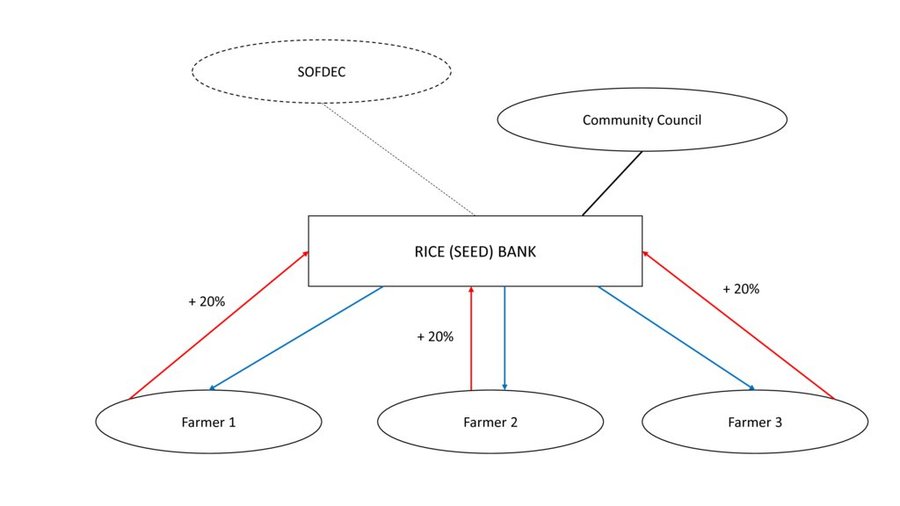
ຜູ້ຂຽນ: HEKS
ການຕັດສິນໃຈໃນການເລືອກເຕັກໂນໂລຢີ ການຄຸ້ມຄອງທີ່ດິນແບບຍືນຍົງ
ການຕັດສິນໃຈໂດຍ
-
ຜູ້ນໍາໃຊ້ດິນຜູ້ດຽວ (ການລິເລີ່ມດ້ວຍຕົນເອງ)
-
ຜູ້ນໍາໃຊ້ທີ່ດິນຫຼັກ, ການສະໜັບສະໜູນ ໂດຍຜູ້ຊ່ຽວຊານ ການນໍາໃຊ້ທີ່ດິນແບບຍືນຍົງ
-
ພາກສ່ວນກ່ຽວຂ້ອງທັງໝົດ, ເປັນສ່ວນໜຶ່ງ ຂອງວິທີທາງແບບມີສ່ວນຮ່ວມ
-
ຜູ້ຊ່ຽວຊານ ຫຼັກດ້ານການຄຸ້ມຄອງ ທີ່ດິນແບບຍືນຍົງ, ມີການຕິດຕາມປຶກສາຫາລືກັບຜູ້ນໍາໃຊ້ທີ່ດິນ
-
ຊຽ່ວຊານ ສະເພາະດ້ານການຄຸ້ມຄອງ ດິນແບບຍືນຍົງຜູ້ດຽວ
-
ນັກການເມືອງ / ຜູ້ນໍາ
ການຕັດສິນໃຈບົນພື້ນຖານ
-
ປະເມີນເອກກະສານ ຄວາມຮູ້ກ່ຽວກັບ ການຄຸ້ມຄອງ ທີ່ດິນແບບຍືນຍົງ (ຫຼັກຖານທີ່ຊ່ວຍໃນການຕັດສິນໃຈ)
-
ຜົນທີ່ໄດ້ຮັບ ຈາກການຄົ້ນຄວ້າ
-
ປະສົບການສ່ວນບຸກຄົນ ແລະ ຄວາມຄິດເຫັນ (ທີ່ບໍ່ເປັນເອກກະສານ)
-
n.a.
ການສະໜັບສະໜູນເຕັກໂນໂລຢີ, ການສ້າງຄວາມອາດສາມາດ ແລະ ການຄຸ້ມຄອງຄວາມຮູ້
ກິດຈະກຳ ດັ່ງລຸ່ມນີ້ ແມ່ນເປັນພາກໜຶ່ງຂອງແນວທາງ
-
ການສ້າງຄວາມສາມາດ / ການຝຶກອົບຮົມ
-
ການບໍລິການໃຫ້ຄໍາປຶກສາ
-
ສະຖາບັນການສ້າງຄວາມເຂັ້ມແຂງ (ການພັດທະນາອົງການຈັດຕັ້ງ)
-
ຕິດຕາມກວດກາ ແລະ ປະເມີນຜົນ
-
ການຄົ້ນຄວ້າ
ການສ້າງຄວາມອາດສາມາດ / ຝຶກອົບຮົມ
ໄດ້ສະໜັບສະໜູນຝຶກອົບຮົມໃຫ້ແກ່ພາກສ່ວນກ່ຽວຂ້ອງດັ່ງລຸ່ມນີ້
-
ຜູ້ນໍາໃຊ້ດິນ
-
ພະນັກງານພາກສະໜາມ / ທີ່ປຶກສາ
ຮູບແບບການຝຶກອົບຮົມ
-
ການເຮັດຕົວຈິງ
-
ຕົວຕໍ່ຕົວ
-
ເນື້ອທີ່ສວນທົດລອງ
-
ກອງປະຊຸມ
-
ຫຼັກສູດ
ກວມເອົາຫົວຂໍ້
Community councils were trained on functioning and administration of the rice bank. Farmers were trained on the multiplication and collection of rice seeds.
ການບໍລິການທາງດ້ານການໃຫ້ຄໍາປຶກສາ
ໄດ້ຮັບການບໍລິການທາງດ້ານການໃຫ້ຄໍາປຶກສາ
-
ໃນພື້ນທີ່ຂອງຜູ້ນໍາໃຊ້ດິນ
-
ສູນຄົ້ນຄວ້າ
-
n.a.
Knowledge exchange between the land users and SOFDEC staff.
Knowledge exchange between SOFDEC and the Provincial Department of Agriculture.
ຄວາມເຂັ້ມແຂງຂອງສະຖາບັນ
ສະຖາບັນ ໄດ້ຮັບການສ້າງຄວາມເຂັ້ມແຂງ
-
ບໍ່ມີ
-
ມີ, ໜ້ອຍໜຶ່ງ
-
ມີ, ພໍສົມຄວນ
-
ມີ, ຫຼາຍ
ໃນລະດັບດັ່ງລຸ່ມນີ້
-
ທ້ອງຖິ່ນ
-
ລະດັບພາກພື້ນ
-
ແຫ່ງຊາດ
ອະທິບາຍສະຖາບັນ, ພາລະບົດບາດແລະຄວາມຮັບຜິດຊອບ, ສະມາຊິກ, ແລະອື່ນໆ.
Community Councils
ຮູບແບບການສະໜັບສະໜູນ
-
ທາງດ້ານການເງິນ
-
ການສ້າງຄວາມອາດສາມາດ / ການຝຶກອົບຮົມ
-
ອຸປະກອນ
ລາຍລະອຽດເພີ່ມເຕີມ
ການຕິດຕາມ ແລະ ປະເມີນຜົນ
Everyday monitoring is ensured by the community council.
For the first 3-4 years after the establishment, SOFDEC monitors the implementation and functioning of the rice banks.
Monitoring aspects:
- No. of members, kg of rice taken out of the bank and payed back to the bank
- General attitude towards the rice bank (are the pay back mechanisms adhered to, etc.)
- Amount of yields and quality of rice (seeds), sometimes optimized
ການສະໜັບສະໜູນທາງດ້ານການເງິນ ແລະ ອຸປະກອນຈາກພາຍນອກ
ງົບປະມານປະຈຳປີ ໃນກິດຈະກຳ ການຄຸ້ມຄອງທີ່ດິນແບບຍືນຍົງ ທີ່ເປັນສະກຸນເງິນໂດລາ
-
< 2,000
-
2,000-10,000
-
10,000-100,000
-
100,000-1,000,000
-
> 1,000,000
Precise annual budget: n.a.
ການບໍລິການ ຫຼື ສິ່ງກະຕຸກຊຸກຍູ້ ດັ່ງລຸ່ມນີ້ ແມ່ນໄດ້ສະໜອງໂດຍຜູ້ນຳໃຊ້ທີ່ດິນເອງ
-
ການສະໜັບສະໜູນ ທາງດ້ານການເງິນ / ອຸປະກອນ ສະໜອງໃຫ້ແກ່ຜູ້ນໍາທີ່ດິນ
-
ຫຼຸດປັດໃຈນໍາເຂົ້າ
-
ສິນເຊື່ອ
-
ສິ່ງຈູງໃຈ ຫຼື ເຄື່ອງມືອື່ນໆ
ເງິນສະໜັບສະໜູນອຸປະກອນ / ສະໜອງໃຫ້ຜູ້ຊົມໃຊ້ທີ່ດິນ
The project provides the materials for for rice bank construction.
ງົບປະມານບາງສ່ວນ
ງົບປະມານເຕັມສ່ວນ
ກະສິກໍາ: ແນວພັນ, ແກ່ນພັນ
Rice seeds for the first season after the implementation of the rice bank is provided by the project.
ການກໍ່ສ້າງ: ຫີນ
All construction materials for the rice bank building is provided by the project. Type of construction (wood or stone) varied depending on the preferences of the village community.
ການກໍ່ສ້າງ: ຫີນ: ໄມ້
All construction materials for the rice bank building is provided by the project. Type of construction (wood or stone) varied depending on the preferences of the village community.
ແຮງງານຂອງຜູ້ນໍ້າໃຊ້ທີ່ດິນ
-
ການອາສາ
-
ລ້ຽງເຂົ້າ - ອາຫານ
-
ຈ່າຍເປັນເງິນສົດ
-
ໄດ້ຮັບການສະໜັບສະໜູນ ອຸປະກອນດ້ານອື່ນ
ການວິເຄາະຜົນກະທົບ ແລະ ສະຫຼຸບລວມ
ຜົນກະທົບຂອງການນໍາໃຊ້ແນວທາງ
ບໍ່
ມີ, ໜ້ອຍໜຶ່ງ
ມີ, ພໍສົມຄວນ
ມີ, ຫຼາຍ
ການຈັດຕັ້ງປະຕິບັດ ວິທີທາງ ສາມາດຊ່ວຍຜູ້ນໍາໃຊ້ທີ່ດິນ ໃນການຈັດຕັ້ງປະຕິບັດ ແລະ ບໍາລຸງຮັກສາ ເຕັກໂນໂລຢີ ການຄຸ້ມຄອງ ທີ່ດິນແບບຍືນຍົງໄດ້ບໍ?
Farmers have access to seed varieties which are adapted to local conditions (e.g. drought and flood resistance), ensuring that yields are also generated in case of an extreme weather event.
ການຈັດຕັ້ງປະຕິບັດ ວິທີທາງ ສາມາດສ້າງຄວາມເຂັ້ມແຂງ ທາງສັງຄົມ ແລະ ເສດຖະກິດບໍ່?
Rice (seed) banks are open to everybody. Thus, economically disadvantaged land users and ethnic minorities participate in rice banks. The rice banks function as safety nets in cases of extreme weather (e.g. droughts, floods) or economic despair.
ການນໍາໃຊ້ ວິທີທາງ ໄດ້ປັບປຸງ ການຄໍ້າປະກັນສະບຽງອາຫານ ຫຼື ປັບປຸງໂຄສະນາການໄດ້ບໍ່?
The rice banks offer year round access to high quality rice seed and rice for consumption all year round and also during extreme weather events. This allows farmers to sow out again in case one harvest gets lost.
The rice bank also benefits farmers with small land plots – they might sell all their yields of new varieties on the market and buy with the return conventional rice for consumption, which is cheaper.
ການຈັດຕັ້ງປະຕິບັດ ວິທີທາງ ສາມາດສ້າງຄວາມອາດສາມາດໃຫ້ຜູ້ນໍາໃຊ້ດິນ ໃນການປັບຕົວ ຕໍ່ການປ່ຽນແປງດິນຟ້າອາກາດ / ຫຼດຜ່ອນຄວາມສ່ຽງທາງໄພພິບັດໄດ້ບໍ?
Increased resilience to extreme weather events because of the availability of both seeds and rice for consumption.
Moreover, the seed varieties stored in the rice bank is adapted to local conditions (e.g. fast maturing, floating rice), ensuring that yields are also generated in case of an extreme weather event.
ການນໍາໃຊ້ ວິທີທາງ ໄດ້ປັບປຸງ ການຈ້າງງານ, ໂອກາດ ໃນການສ້າງລາຍຮັບບໍ່?
The new varieties promoted through the rice banks have higher yields, thus leading to more income for the farmers. Farmers also get higher prices on the market for the new rice varieties.
ສິ່ງກະຕຸກຊຸກຍູ້ໃຫ້ຜູ້ນໍາໃຊ້ທີ່ດິນ ໃນການປະຕິບັດການຄຸ້ມຄອງທີ່ດິນແບບຍືນຍົງ
-
ການຜະລິດເພີ່ມຂຶ້ນ
-
ກໍາໄລເພີ່ມຂຶ້ນ (ຄວາມສາມາດ), ການປັບປຸງຄ່າໃຊ້ຈ່າຍ, ຜົນປະໂຫຍດ, ອັດຕາສ່ວນ
-
ຫຼຸດຜ່ອນດິນເຊື່ອມໂຊມ
-
ຫຼຸດຜ່ອນຄວາມສ່ຽງຂອງໄພພິບັດ
-
ການຫຼຸດຜ່ອນພາລະວຽກ
-
ການຊໍາລະເງິນ / ເງິນອຸດໜູນ
-
ກົດລະບຽບແລະລະບຽບການ (ລະອຽດ) / ການບັງຄັບໃຊ້
-
ກຽດສັກສີ, ຄວາມກົດດັນທາງສັງຄົມ / ການຕິດຕໍ່ກັນທາງສັງຄົມ
-
ລວມເຂົ້ານໍາກັນກັບການເຄື່ອນໄຫວ / ໂຄງການ / ກຸ່ມ / ເຄືອຂ່າຍ
-
ຄວາມຮັບຮູ້ ທາງສີ່ງແວດລ້ອມ
-
ພາສີ ແລະ ຄວາມເຊື່ອຖື, ສົມບັດສິນທໍາ
-
ການປັບປຸງ ຄວາມຮູ້ ແລະ ຄວາມສາມາດ ຂອງການຄຸ້ມຄອງ ທີ່ດິນແບບຍືນຍົງ
-
ການປັບປຸງຄວາມງົດງາມ
-
ການຫຼຸດຜ່ອນຂໍ້ຂັດແຍ່ງ
-
well-being and livelihoods improvement
ຄວາມຍືນຍົງຂອງການຈັດຕັ້ງປະຕິບັດກິດຈະກໍາຂອງແນວທາງ
ຜູ້ນໍາໃຊ້ທີ່ດິນ ສາມາດຈັດຕັ້ງປະຕິບັດຕາມແນວທາງໄດ້ເອງບໍ່ (ໂດຍປາດສະຈາກການສະໜັບສະໜູນຈາກພາກສ່ວນພາຍນອກ)?
Initial coaching by SOFDEC is needed, however, after 3 years the rice banks function without any external support.
ບົດສະຫຼຸບ ແລະ ບົດຮຽນທີ່ໄດ້ຮັບ
ຄວາມເຂັ້ມແຂງ: ທັດສະນະມູມມອງ ຂອງຜູ້ນໍາໃຊ້ທີ່ດິນ
-
The rice banks offer access to high quality seeds to all farmers in the community.
-
Increased food security and resilience due to the permanent availability of rice seeds or rice for consumption.
-
More income due to higher yields and better prices for new varieties.
-
After about 3-4 years, the banks mostly work independently.
ຄວາມເຂັ້ມແຂງ: ທັດສະນະມຸມມອງ ຂອງຜູ້ປ້ອນຂໍ້ມູນເອງ
ຈຸດອ່ອນ / ຂໍ້ເສຍ / ຄວາມສ່ຽງ: ທັດສະນະມູມມອງ ຂອງຜູ້ນໍາໃຊ້ທີ່ດິນວິທີການແກ້ໄຂແນວໃດ
-
Limited amount of rice (seed) to be borrowed.
Increase the storage capacity and conditions.
-
Required technical and managerial knowledge for the community councils is high.
Regular training sessions by SOFDEC
-
Rodents or insects might destroy the rice.
Apply narrow-mash nets to protect the rice from rodents and other animals
-
Some farmers do not comply with the required interest rates, delays in payback, etc.
Make a contract with them, decide on a step by step pay back manner, or if the farmer is not able repay (sick family member, loss of land, etc.) the whole group can decide to waive the debts
ຈຸດອ່ອນ / ຂໍ້ເສຍ / ຄວາມສ່ຽງ: ທັດສະນະມຸມມອງ ຂອງຜູ້ປ້ອນຂໍ້ມູນເອງວິທີການແກ້ໄຂແນວໃດ
-
Seeds are treated with pesticides to make them last.
Improve the storage conditions or use different techniques to prevent pests (Integrated Pest Management IPM)
-
Only rice is considered.
Introduce a similar approach also for other plants in order to diversify the farmers’ income. Allow the farmer to pay back with other crops or varieties.
-
None
ເອກກະສານອ້າງອີງ
Editors
-
Stefan Graf
-
Christoph Kaufmann
-
Christine Lottje
-
Judith Macchi
ການທົບທວນຄືນ
-
Boris Orlowsky
-
Alexandra Gavilano
-
Judith Macchi
ວັນທີຂອງການປະຕິບັດ: Feb. 15, 2017
ປັບປຸງລ່າສຸດ: March 12, 2021
ບຸກຄົນທີ່ສໍາຄັນ
-
Lean Hak Khun (kleanghak@yahoo.com) - ຜູ້ຊ່ຽວຊານ ດ້ານການຄຸ້ມຄອງ ທີ່ດິນແບບຍືນຍົງ
-
Sreytouch Bin - ຜູ້ຊ່ຽວຊານ ດ້ານການຄຸ້ມຄອງ ທີ່ດິນແບບຍືນຍົງ
-
Mesa Say - None
-
Khonhel Pit - ຜູ້ຊ່ຽວຊານ ດ້ານການຄຸ້ມຄອງ ທີ່ດິນແບບຍືນຍົງ
ການບັນຍາຍລາຍລະອຽດ ໃນຖານຂໍ້ມູນ ຂອງ WOCAT
ຂໍ້ມູນການເຊື່ອມໂຍງຂໍ້ມູນການຄຸ້ມຄອງການນໍາໃຊ້ດິນແບບຍືນຍົງ
ເອກກະສານ ແມ່ນໄດ້ອໍານວຍຄວາມສະດວກໂດຍ
ສະຖາບັນ
ໂຄງການ
- Book project: where people and their land are safer - A Compendium of Good Practices in Disaster Risk Reduction (DRR) (where people and their land are safer)
ເຊື່ອມໂຍງກັບ ຂໍ້ມູນຕ່າງໆ ທີ່ກ່ຽວຂ້ອງທີ່ມີ
- The Society for Community Development in Cambodia (SOFDEC) is a Cambodian Non-Governmental Organization, established in 2006 through the localization of HEKS (the Swiss Church Aid) project in Kampong Chhnang province, Cambodia. The vision of SOFDEC is that Cambodian people living in Cambodia live a state of comfort, equality, equity, and have ownership over the sustainable development of their community. The mission of SOFDEC works in partnership with community based organizations and relevant institutions through integrated community development, research, human resource development, enhancement of family economies, in the hopes to uplift the living standards of the people in the target areas. Our goal aims to uplift the living standards of the rural people of Cambodia through the improvement in income generation, sustainable agricultural practices, microfinance, health, human resource development, and sustainable natural resource management.: www.sofdec.com
